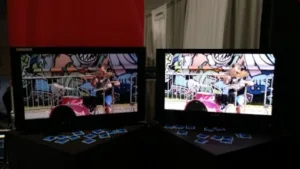Harmonic had a very nice demo running in its booth at NAB, but it could also let visitors come to the wrong conclusion. There were supposed to be four different demos running, but the two HLG demos (#3 and #4) were not working on the two times we visited the booth. There also seemed to be confusion at the Harmonic booth between the first and second demos so it was unclear which one was running at any time. (also see video)
In demo number 1, three identical LG OLED TVs were set up and running on the wall. The one on the left was set to run in HDR mode and receive HDR10 content. The one in the middle was in SDR mode and received SDR content, while and the one on the right was in HDR mode and set to receive content that was upconverted from SDR to HDR at the distribution encoder (the Vibe4K encoder) with the algorithm provided by a company called b<>comm (don’t ask me how that is pronounced!).
Content was a NASA loop that showed space station footage and images of the sun and moon. As it turned out, there were two different grades of this content – the HDR and the SDR grades, that were used to directly feed the left and middle TVs. The SDR version was then upconverted to HDR in the Vibe4K encoder and delivered as HDR10 content to the right TV.
Below are a couple of screen shots of the content. In the one with the clouds, more detail in the highlights are visible in the left (HDR) image while the lower luminance range of the SDR is clearly visible.

Now here’s the rub with this demo. One would think that you should naturally compare the upconverted SDR image to the native HDR images, but there was an issue with the demo. As we later found out in out interview with b<>comm, their SDR-to-HDR upconverter only works on the luminance profile, expanding the dynamic range to enable the viewing of greater detail in the highlights and shadows. Therefore, the output remains in the same Rec. 709 color gamut as the incoming SDR content.
In the photo below, note that none of the reds are the same color. We would expect the SDR and SDR up-conversion colors to be the same as they are both supposed to be rec. 709, so something strange is going on.

This expansion in luminance dynamic range while preserving the colors, was correctly demonstrated in the b<>comm booth (image below) using two professional monitors. In the Harmonic booth, comparing the left and middle TV did show a change in the luminance profile, but it also showed significant color differences between the two TVs. The reason was not clear, but it would appear the right TV with the upconverted input was doing some additional color space conversions.

This highlights an important issue with the transmission of HDR content. It now seems necessary to have two flags in the metadata – one for the type of EOTF (PQ or HLG) and one for the color gamut (2020 or 709 or P3). The upconverted b<>comm format encoded the rec. 709 colors in a BT 2020 container, but problems still ensued.
For demo #2, the middle TV was supposed to accept SDR content and use the internal SDR-to-HDR converter. We never did get to see this side-by-side nor the HLG demos either. – CC

